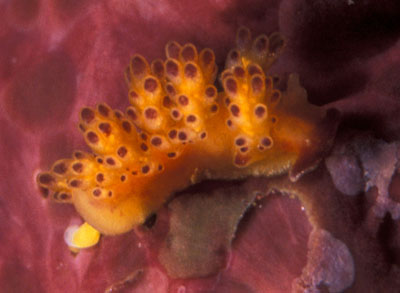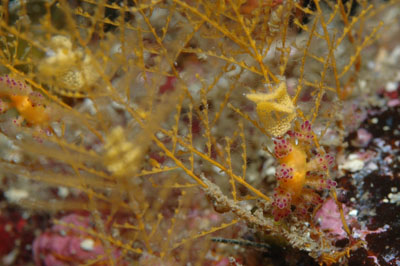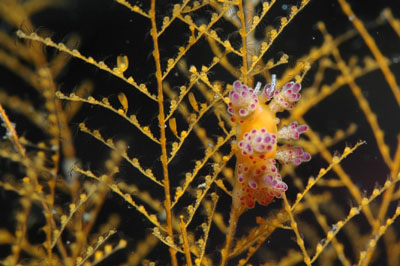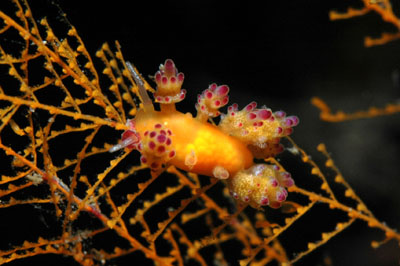New Zealand's Yellow, Doto cf. bella
4 January 2005
Dive Number 882
Mary's Wall / The Gardens
Poor Knights Islands
At the end of a long dive, John Layne and I are decompressing in shallow water
when I find three tiny, scarcely recognisable yellow nudibranchs. I only noticed them because their egg masses were a bright yellow colour. John was most unimpressed when I showed them to him and even I wasn't sure they were slugs. Without a camera I could do nothing more than make this crappy sketch of them in my log book and commit to finding these things again and photographing them. I could just make out lumpy appendages on their backs and tentatively thought they might be a Doto species.
15 January 2005
Dive Number 886
Northern Arch
Poor Knights Islands
On a solo dive I again find one of the tiny yellow slugs. This one is not amongst the yellowish hydroid where I found them before and looks out of place. On taking a close look at the photos, this slug looks to be damaged: perhaps it has been the victim of an attack.
20 August 2005
Dive Number 932
Landing Bay Pinnacle
Poor Knights Islands
On this dive I finally get some decent shots of the elusive Doto. It's at the top of the pinnacle in about 6 metres of water and looks to be in its element, in a forest of tiny hydroids.
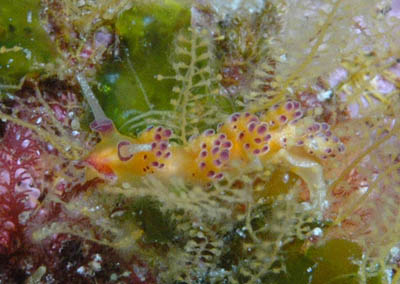
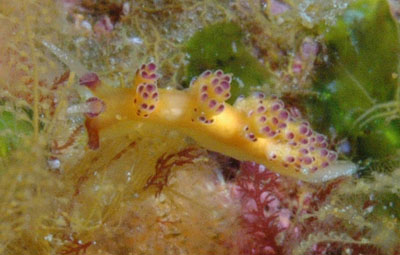
4 May 2006
Dive Number 984
Cording Islands
Isthmus Sound
Preservation Inlet
Fiordland
I am very surprised to find what appears to be the same little yellow Doto in cold water at the opposite end of the country.
The yellow hydroid, their happy hunting ground, appears to be the same as the one at the Knights.
10 December 2006
Dive Number 1029
Landing Bay Pinnacle
Poor Knights Islands
As Marcie and I neared the top of the pinnacle towards the end of a long, slow, slug hunting dive, I wondered whether the Dotos I'd previously found here would still be around.
Sure enough, very close to the top of the pinnacle, their bright yellow egg masses give them away and I can just make out a slug in amongst the yellow hydroids. I point the eggs and slug out to Marcie but I don't think she can see them. That's understandable: I wouldn't have seen the slug if I hadn't snapped these things before.
They're so damn small it is hard to get a decent shot of them. In this photo, there's obvoiusly another slug to the left but I never saw it. With these things being the size they are, going through photos after the dive reveals a level of detail which was totally invisible during the dive.
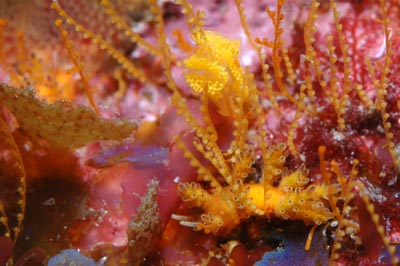
17 December 2006
Dive Number 1033
Tie Dye Arch, The Pinnacles
Poor Knights Islands
I could only get bad photos of them but here they are again.
So, it now seems reasonable to call these slugs common.
They blend in very well with their yellow hydroid food source and are hard to see but the bright yellow eggs do make them a lot easier to spot.

16 April 2007
Dive Number 1087
Preservation Inlet
Fiordland
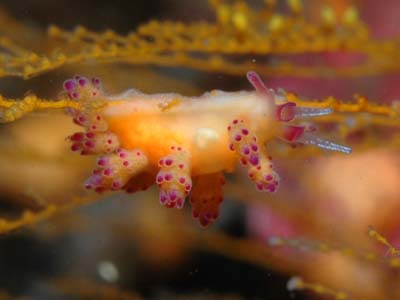
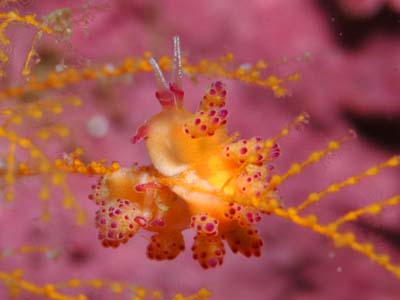
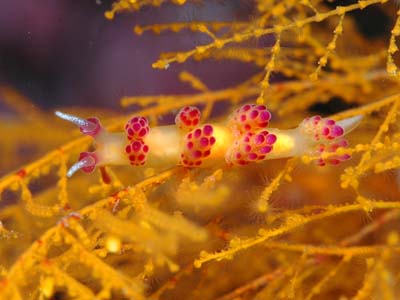
30 January 2010
Dive Number 1306
Landing Bay Pinnacle
Poor Knights Islands
At 5 metres depth, very close to the top of the pinnacle, these slugs can be reliably found in amongst the orange hydroids.
The difficulty with finding and photographing them is that in such shallow water, any swell or surge makes it tricky to stay in one position for long enough to home in on them.
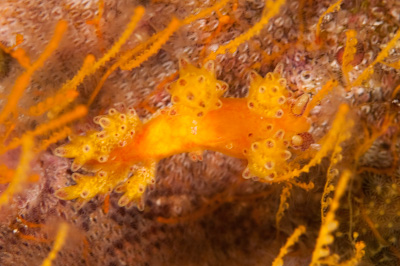
23 September 2010
Dive Numbers 1368 & 1369
The Gut & Shelter Islands
Doubtful Sound
Fiordland
Once again, I acquaint myself with these little treasures in Fiordland. They seem common and easier to find and photograph than they are at the Poor Knights.
At the Knights, they're so often in very shallow water (~6m) where any surge makes it difficult to focus on something so small. In Fiordland there's often no swell to contend with and they just seem less hidden away in the (Halopteris campanula ?) hydroids.
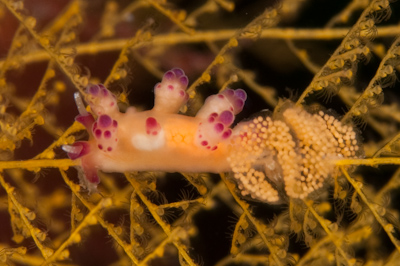

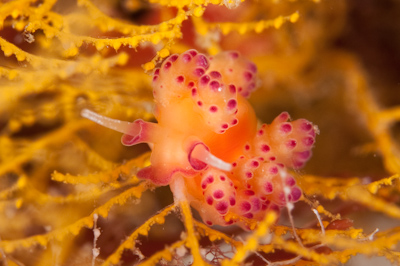
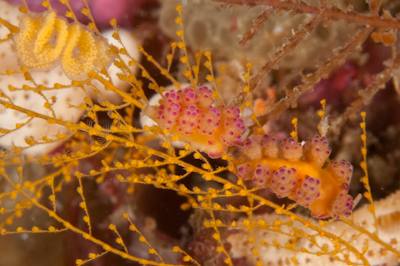
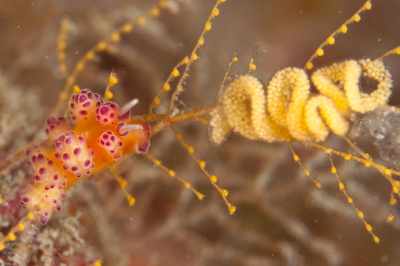
10 April 2013
Dive Number 1589
Princes Islands
Three Kings Islands
After a break of many years, I made it back to the Three Kings, a place where I'd never seen these little guys before. The Kings are so rich in invertebrate life I suppose it would be surprising if they weren't there. Sure enough, there they were although not abundant and I found only a few.
We were part of an Auckland Museum/Te Papa/NIWA trip with a bunch of scientists who were busy collecting stuff. I had a small sample bottle with me and captured one of these little beauties for science. Somewhere in some dark basement in Wellington, at Te Papa or NIWA, is a is a pickled tiny little yellow Doto... as far as I know, still to be described by a specialist marine mollusc taxonomist.
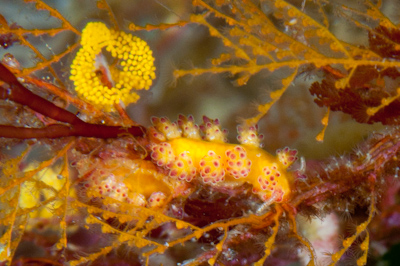
5 April 2014
Dive Number 1637
Porpoise Point
Dusky Sound
Fiordland
Fiordland again proves to be the best location to find and photograph the yellow Doto.
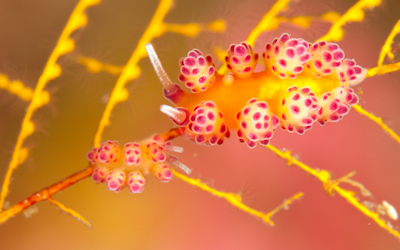
5 April 2014
Dive Number 1638
Acheron Passage
Dusky Sound
Fiordland
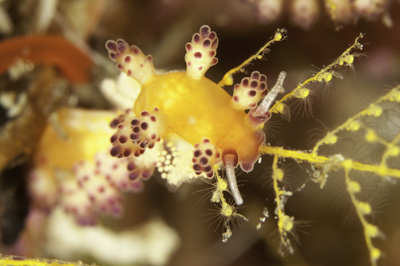
![]()
© 2006 - 2014 ianskipworth.com

